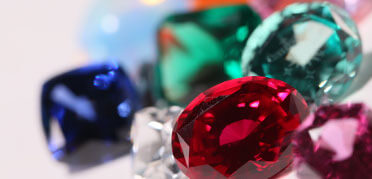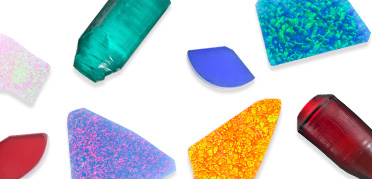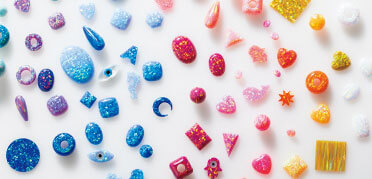Jewelry Glossary
-
S
-
Sack-type Prong
A sack-type prong is used to set the gemstones of baguette-cut, marquise-cut, and pear-shaped cut because the sharped edge of these gemstones could be cracked if set by square prongs.
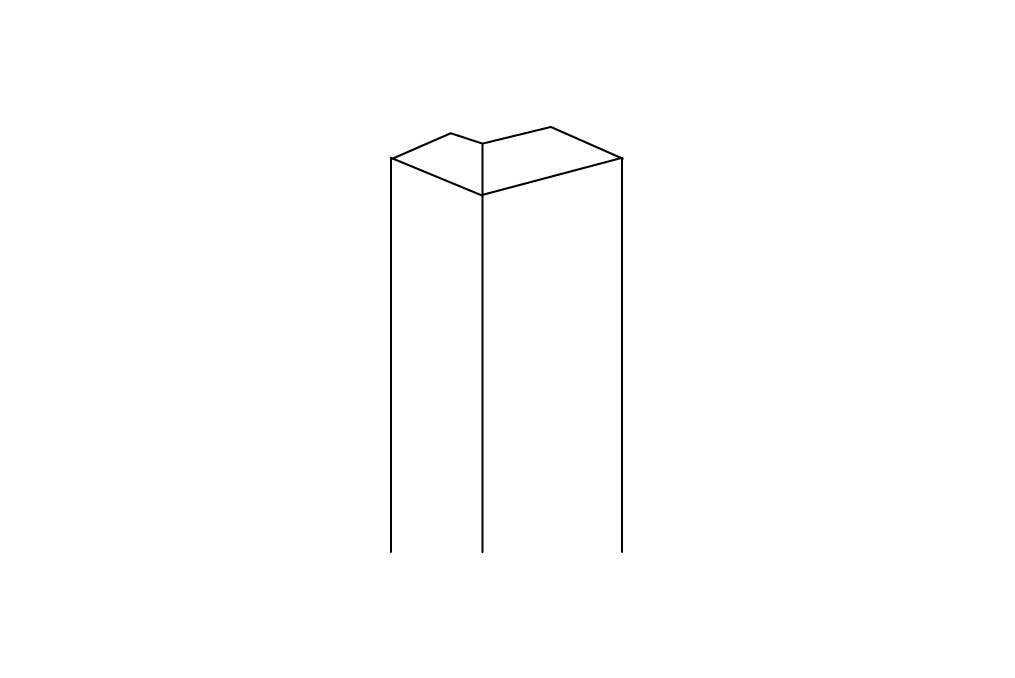

- Sack-type Prong -

-
Sapphire
Sapphires are made up of the same mineral as rubies and second only to diamond in terms of hardness. Sapphire means blue in Latin, gems possessing the right coloration and transparency are deemed to be of high quality.
Sri Lanka and Madagascar are the main producers, however currently many sapphires in the market are treated by heat.
Kyocera's Crescent Vert sapphire has the same composition with natural sapphire and highly valued for its cornflower blue color.
Please click
here
to learn more about Kyocera's Crescent Vert sapphire.

Sapphire
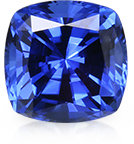
While sapphire comes in many colors, deep blue sapphire is the most famous and the standard against which other blue gemstones are measured. This ancient gemstone is said to bring wisdom, protect the wearer from evil, and promote healing. Its bright blue sparkle has been loved for centuries as a symbol of the heavens and source of faithfulness and peace of mind.
Our Crescent Vert blue sapphire is highly valued for its cornflower blue color.Available in sizes up to 10 carats.* If you need a larger stone, please contact us.View Comparison Table Item Crescent Vert Blue Sapphire Natural Blue Sapphire Chemical Composition Al2O3 Al2O3 X-ray Diffraction Same as natural stone A pattern specific to Blue Sapphire Spectroscopic Analysis Same as natural stone Specific absorption of Blue Sapphire Crystal System Hexagonal Hexagonal Mohs Hardness 9 9 Specific Gravity 4.01 3.90 ~ 4.00 Melting Point 2050°C 2050°C Transparency Transparent Transparent Refractive Index 1.762 ~ 1.770 1.760 ~ 1.768 / 1.770 ~ 1.779 Double Refraction 0.008 0.008 ~ 0.010 Average Dispersion 0.018 0.018 Pleochroism Pale greenish blue/dark blue Pale greenish blue/dark blue Chelsea Color Filter Examination Unchanged Black green, Unchanged
[Moh's hardness: 9] [Mineral type: Corundum] -
Sash Band
The sash band is a piece of Japanese traditional jewelry. It is mainly used for Japanese kimonos and occasionally used as a brooch. There are many kinds of sash bands. Some variations include: metal only decorations; gemstone decorations such as jade, opal, pearl, and amber; ivory or coral carved decorations.
-
Satin Finish
A satin finish is a textured version of a hair line finish.
It is expressed by crossing small/thin lines. -
Scapolite
Scapolite is named after scapos, meaning sticks for its columnar shape and lithos, meaning stone lights in Greek. It is often mistaken for amethyst and topaz due to the similarity of the refractive index. Scapolite crystals that contain tubular inclusions cause chatoyancy by polishing to cabochon cut.
[Moh's hardness: 6] [Mineral species: Scapolite] -
Scheelite
Scheelite was named in 1821 by Sweden's Chemist Karl Wilhelm Shale. High transparency and bright color scheelite can be found, but there is a disadvantage that it easily cracks due to cleavage showing only in one direction.
[Moh's hardness: 4.5-5] [Mineral species: Scheelite] -
S-curb Chain
An s-curb chain is created by deforming a round line.
-
Sheen
Sheen is a blueish milky light that appears on the cabochon of moon stone. It occurs when lights reflected by many layers in a gemstone interfere with each other. It is also called adularescence.
-
Selenite
Selenite derived from "selene," meaning moon in Greek, and it is a crystal whose transparency is similar to plaster. The tumble selenite is quite transparent and has a gloss like moonlight or silk thread. It can be easily hurt with nails (nails' hardness: 2 1/2) because its hardness is 2. Alabaster is a massive microcrystalline assembly and has been used as a material for sculptures and decorations for a long year.
[Moh's hardness: 2-2.5] [Mineral species: Gypsum] -
Semi Precious Stone
Semi-precious stones are not so precious, hard, and expensive, such as amethyst, lapis lazuli, and turquoise. However, they have moissanite, whose moh's hardness is 9.25, and paraiba tourmaline in semi-precious stones. So, it is general to sort stones out depending on the quality.
-
Serpentine
Serpentine is a group name that contains at least 16 types of water-containing silicate minerals. The name was given due to the rough stone looks similar to snakeskin. Since there were plentiful and easy to process, the stone beads were made into necklaces from the Paleolithic. The color ranges from slightly transparent to opaque and is polished flat to emphasize its patterns or cabochon.
In Western countries, this gem has been considered the same stone as jade or nephrite.
[Moh's hardness: 2.5-6] [Mineral species: Serpentine] -
Shank
The shank is the hoop part of a ring that serves as its foundation, similar to that of a building. There are various types of shanks, as shown in the figures below.
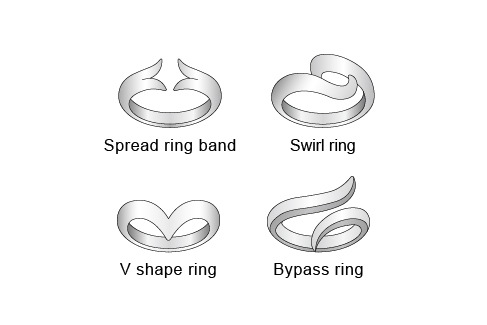

- Shank -

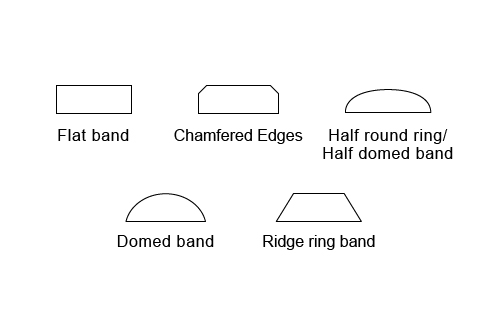

- Shank -

-
Shell
Shell covers a mollusk. Shells with pearl layers are cut and polished for making jewelry, and they will be sold as "mother of pearl." In addition, shells with layer patterns are used for sculptures such as cameos.
Some shells are colored in a bright color.
[Moh's hardness: 2.5-3] [Organic matter: Shell] -
Shirocho Pearl
The round-shaped shirocho pearls, that are more than 10mm, have a good reputation. Silver and gold pearls can be collected. As there is no nucleus bead, the layer is thick and the shape is irregular. Shirocho pearl was once an important material for buttons.
[Moh's hardness: 2.5-3] [Organic matter: Cultured pearl] -
Shortner
A shortner is an optional auxiliary metal used in arranging the length of pearl necklaces.
-
Shower Necklace
A shower necklace is a gorgeous necklace with many decorations on the front. It is also called a "bib necklace."
-
Sillimanite
Sillimanite is the polymorphism of
andalusite and kyanite. Although chemical compositions are the same, different crystal structures, have been made due to differences in temperature and pressure at crystalline. Professor Benjamin Silliman (1779-1864) was named the mineral name in the United States.
[Moh's hardness: 6] [Mineral species: Sillimanite] -
Silver
Silver is a white precious metal, and its major production countries are Mexico, Peru, Russia, Canada, the United States, etc. The color of silver can change to black when used for a long time. This change is called sulfurization.
For jewelry use, as silver is too soft, other metals are added to make silver alloys. Silver 950, 925, 900 are popular for jewelry use.
Compared with gold or platinum, the specific gravity is small, and the price is low, so it is good for jewelry designs that use a lot of metal.
As the melting point is low, it is easy to do brazing. On the other hand, as the thermal conductivity is high, it is difficult to re-size the ring with a stone setting. -
Silver 900
Silver 900 indicates silver alloys made of 90% silver and 10% copper. They used to be used as coins, so they are called "coin silver" as well. As it is solid, jewelry that needs hardness, such as chain, tends to be made using silver 900.
-
Silver 925
Silver 925 is a silver alloy of 92.5% silver with 7.5% copper, which increases its hardness.
Silver 925 is called "sterling silver," and it is very popular all over the world.
In Europe and the United States, it is more common than silver 950. Also, in Japan, silver 925 is often used for mass production as the alloy is easier to cast than silver 950.
Silver 925 can increase its hardness depending on the condition of heat treatment. -
Silver 950
Silver 950 is very popular for jewelry making.
It is a silver alloy of 95% pure silver with 5% of copper, which increases its hardness. -
Silver Coloring Finish
Silver coloring finish is a texture that colors a part of silver black via surface treatment. This technique has been traditionally used in Japan since the Edo Period.
-
Singapore Chain
A Singapore chain is made by twisting the double kihei chain (curb chain), and it gives it a sense of volume despite its weight.
-
Single Row Ring
A single row ring is a ring with several same-size stone cuts set in a row. Typically, 5- or 7-piece gemstone sets are used for this design.
-
Sinhalite
Sinhalite had been believed as brown peridot for a long time, but turned out to be a new type of mineral at the beginning of the 20th century. Mostly, the color of sinhalite is a soft brown.
[Moh's hardness: 6] [Mineral species: Sinhalite] -
Smithsonite
lts name derived from British James Smithson (1765 -1829). Smithson was a wealthy man who had never been married was immersed in research on chemistry and mineralogy. His property was donated for the use of education in Washington DC, USA and Smithsonian Museum was established later on. Smithsonite has almost all kinds of colors, excluding orange, and the charm of this gem is its soft and semi-transparent color.
[Moh's hardness: 4] [Mineral species: Smithsonite] -
Smoky Quartz
The color of smokey quartz is from light brown to black. Smokey quartz are generally irradiated with radiation.
[Moh's hardness: 7] [Mineral species: Quartz] -
Snake Chain
For a snake chain, a thin wire is molded into a fish scale shape, and the connecting parts are made by crimping them together. Its flexibility is associated with a snake. It has a caulking structure and is scaled, so it looks like a metal string from a distance.
-
Snake Ring
The snake ring is a ring in the shape of a serpent whose double wrap arm is suggestive of smoothness and undulation of snake skins. Snakes are regarded as god’s servants and a symbol of eternity. In Japan, many people who wear this ring believe it will protect themselves from evil.
-
Sodalite
Sodalite was named in 1911 due to the high sodium content (soda). The color is more bluish-purple than lapis lazuli, and white calcite patterns can be seen. As a subspecies, there is a hackmanite that contains slightly sulfur. The pink or purple color strongly appears under UV lights.
[Moh's hardness: 5] [Mineral species: Sodalite] -
Solitaire
For this style, 4 or 6 prongs are used to set a center stone in a specific place.
-
Solvothermal Synthesis
Solvothermal synthesis is one of the production methods of lab-grown gemstones (mainly crystal). This process was developed in the early 1950s in the United States. The process is the same as the hydrothermal process, but the type of solvent differs.
-
Spectrometer
A spectrometer is a tool to examine the amount of light absorbed through a prism.
-
Spessartite Garnet
Spessartite, is named after Bavaria region's Spessart, Germany, where it was first discovered.
Chemically pure stones are pale yellow, but they become orange-dark red when other elements are added. Orange stones are also called a mandarin garnet because its bright color is associated with orange fruits.
[Moh's hardness: 7] [Mineral species: Spessartite garnet] -
Sphene
Mineral's name for sphene is titanite, as it includes titanium. Sphene in Greek means a wedge shape, and it is crystal shape. The colors are yellow, green or brown with transparency, and dispersion is stronger than diamonds.
[Moh's hardness: 5][Mineral species: Titanite] -
Spike Triple Chain
A spike triple chain is a chain designed like a long U-shaped braided chain.
Each surface is sharply cut, so the reflection of light is beautiful. -
Spinel
There are six types of color for spinel: red, orange, green, blue, indigo blue, and red purple.
All hues are produced, and it has a hue name such as red spinel when it is called as a gemstone. It is named after spina meaning thorn in Latin because its octahedral crystals are associated with small thorns. -
Spiral Ring
A spiral ring is a ring made of a metal wrapped in two to four layer spirals. It can be used as a free-size ring.
-
Spring Ring
A spring ring is a connecting part of a necklace.
-
Square Prong
A square prong is one of the basic shapes of prongs along with round prongs. Its cross-section is square-shaped and gets thinner at the edges.
-
Stackable
A style of wearing jewelry where small gemstones are stacked on top of each other.
-
Star Ruby
If observed under direct light some rubies display a six pointed star pattern. This type of ruby is called star ruby and the star pattern effect is called asterism. When a silk inclusions are found within corundum, which is translucent, it will be cut and polished into cabochon.
The crystal rutile needles, which are collectively called "silk" due to their opaqueness and color, cause the star effect.
In Sri Lanka, heating (around 1000 degrees) the gemstones is used to remove the blue color of ruby. It is very difficult to cut and polish this deep red ruby to show a six pointed star in the center.
Crescent Vert star ruby features a six pointed star shimmering across the gem’s surface as it proudly shines bright red.
Please click
here
to learn more about Kyocera's Crescent Vert star ruby.

Star Ruby
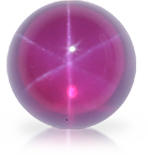
Star ruby, in a cabochon cut, emits six distinct rays of light. These asterisms are named for the Greek word meaning “star.”
This mysterious phenomenon—starlight reflected inside the gemstone—is caused by trace needle-formed rutiles and corundum within the gem. Crescent Vert star ruby features a six-rayed star shimmering across the gem’s surface as it shines bright red and full of dignity.Available in sizes up to 10 carats.* If you need a larger stone, please contact us.View Comparison Table Item Crescent Vert Star Ruby Natural Star Ruby Chemical Composition Al2O3 Al2O3 X-ray Diffraction Same as natural stone A pattern specific to Star Ruby Spectroscopic Analysis Same as natural stone Specific absorption of Star Ruby Crystal system Hexagonal Hexagonal Mohs Hardness 9 9 Specific Gravity 4 3.90~4.01 Melting Point 2050℃ 2050℃ Transparency Transparent ~ Translucent Transparent ~ Translucent Refractive Index 1.762~1.770 1.762~1.770 Double Refraction 0.008 0.008 Average Dispersion 0.018 0.018 Pleochroism Yellowish red, Bright red Strong bright red
[Moh's hardness: 9] [Mineral type: Corundum] -
Star Sapphire
Star sapphire in a cabochon cut reveals needle-shaped mineral inclusions that reflect light to form an asterism effect. The quality of the base color mainly determines a star sapphire's value. In addition, sapphires with straight star arms that appear on all sides evenly are the most sought after.
Crescent Vert star sapphire, bold bright and blue, displays distinctively beautiful starlight lines.
Please click
here
to learn more about Kyocera's Crescent Vert star sapphire.

Star Sapphire

The mysterious star sapphire is said to focus the mind with its three intersecting lines of light representing faith, hope and destiny. Star sapphire in a cabochon cut reveals needle-formed mineral inclusions that reflect the light and shine in asterism. Crescent Vert star sapphire, bright blue and full of dignity, displays distinctively beautiful starlight lines.
Available in sizes up to 10 carats.* If you need a larger stone, please contact us.View Comparison Table Item Crescent Vert Star Sapphire Natural Star Sapphire Chemical Composition Al2O3 Al2O3 X-ray Diffraction Same as natural stone A pattern specific to Star Sappfire Spectroscopic Analysis Same as natural stone Specific absorption of Star Sappfire Crystal system Hexagonal Hexagonal Mohs Hardness 9 9 Specific Gravity 4 3.98~4.06 Melting Point 2,050℃ 2,030~2,050℃ Transparency Transparent ~ Translucent Transparent ~ Translucent Refractive Index 1.762~1.770 1.762~1.770 Double Refraction 0.008 0.008~0.009 Average Dispersion 0.018 0.018 Pleochroism Dichroism (Greenish-blue, Dark blue) Dichroism (Greenish-blue, Dark blue) Chelsea Color Filter Examination Dark red Dark red - Unchanged
[Moh's hardness: 9] [Mineral type: Corundum] -
Star Setting
Star setting is a technique for bead setting.
By curved 8 sunray marks, the diamond looks bigger and more brilliant. -
Steady Ring (Pair Ring)
A steady ring is worn as "the proof of love" and is often worn on the ring finger like the engagement ring. It indicates that they promise a future with a specific partner regardless of engagement.
-
Step Cut
Facet cut made with square facets is called step cut.
-
Sterling Silver
Please refer to "silver 925."
-
Stone Setting
Stone setting is the final jewelry manufacturing process and fixes a gemstone to a mount. Styles can be categorized into four types: prong setting, bezel setting, bead setting, and others.
-
Stud Earrings
Stud earrings are worn on your earlobes, it is a non-moving kind of earring which is also referred to as button type.
There are various types of designs, such as the small round ball and the button shape.
It can be made of various materials, such as precious metals and natural stones. -
Sugilite
Sugilite was named after Dr. Sugi Kenichi, a Japanese petrologist who is one of the discoverers.
Sugilite was discovered in 1944 and certified as a new mineral in 1976. The color range is from pink to purple and often cut to the cabochon.
[Moh's hardness: 5][Mineral species: Sugilite] -
Sunstone
Sunstone is a shining red stone when polishing to cabochon because the fine hematite of inclusions reflects light. It sometimes emits aventurescence, chatoyancy, and asterism depending on the array of inclusions.
[Moh's hardness: 6] [Mineral species: oligoclase / Labradorite]
-
